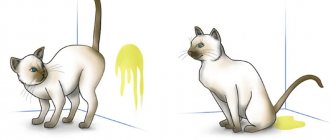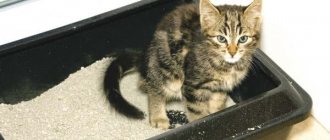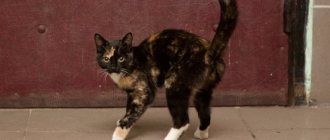There are several explanations for why your cat suddenly abandoned her litter box and began defecating in the shower, bathtub, or sink. This is a stinking and completely unpleasant turn of events.
Fortunately, if the animal is healthy, you can probably stop this unwanted behavior by changing the decor of your bathroom to make the litter box more attractive.
Cat bathroom behavior varies between cats, and litter box problems can be caused by underlying health conditions, stress, environmental factors, or a combination of any of these.
It may be helpful for you to spend some time analyzing your cat's emotional and physical health to determine what the problem is and how best to address it.
Why do cats defecate in the bathtub or sink?
Cats are generally very clean and tidy animals. When your cat defecates in a restricted area after conscientiously using the litter box, she is trying to tell you something.
First, check the tray to make sure it's not full, smelly, or tipped over. Also, make sure nothing is blocking your cat's access to the litter box.
Anything that seems inappropriate for your cat in the litter box may encourage her to take her business elsewhere.
Your capabilities and cat's needs
Animals, like people, have their own character and their own needs. Very clean animals may not tolerate poop in their litter box and will defiantly go to the bathroom. Why is this suddenly happening? There can be many reasons:
- you went to work and can no longer run all day to the pussy tray to clean it;
- you adopted a cat for foster care and did not expect such behavior, because your animal is less whimsical;
- for some reason you are forced to change the manufacturer of the filler. And the new litter, according to the cat, does a poor job of absorbing odor or moisture;
- you got another animal, which decided that the litter box of the first cat suited it very well and “spoiled” it with its smell.
Essentially, the cat is telling you: when I go to the bathroom, you immediately clean up the pile, but it stays in my tray for a long time. I do not like it!
What to do with all this? Go choose a new filler. Try what your cat might like. For example, purchase a larger tray in which the animal can bury its feces while you are away from home. Just look, it takes a month for the cat to get used to the new offer. Also make sure that other animals do not pee in the cat's litter box.
But, there is another approach. Some animal psychologists recommend offering such perfectionist animals to use the toilet. Just make or buy a cat stand so that he doesn't fall into the toilet, and drop him off for big errands for a while. Interestingly, there is a certain percentage of cats who really like it. And who willingly begin to relieve themselves just like people. Moreover, according to behavioral experts, “sitting” on a hill is regarded by animals as a safer place. Like, I sit high, I look far away, I control everything.
Health problems
Then consider the health problem. Cats that make a point of defecating in front of their owner, squatting to pee or poop in your presence, may be crying out for help.
Cystitis (inflammation of the bladder) and bladder stones sometimes cause cats to defecate (and urinate) in inappropriate places, and they may highlight this by posing in front of their human. For example, painful bowel movements due to constipation.
This may encourage cats to avoid the litter box if they associate it with discomfort. If you suspect this change is caused by a health problem, make an appointment with your veterinarian immediately.
The veterinarian will likely perform a physical examination and may also use blood tests or x-rays to determine if there is an infection or problems with digestion or urination.
Stress
Thirdly, the general stress situation in the animal. The cat has changed its place of residence twice in the last period of time: its previous owners abandoned it and gave it to a shelter, then again to a new home. Cats generally hate sudden changes in their lives!
Something needs to be done! So, we have looked at the most likely reasons. But this is not all, because for each cat everything is strictly individual. So, a cat can simply mark the sink and bathtub with his feces - that’s how he likes them. He likes that these items now hold his scents.
An important factor: the cat has had its claws removed. These cats find it very unpleasant to dig around in the litter box and prefer cool, smooth surfaces. The bathtub and sink fit perfectly!
Behavioral problems
Changes in household dynamics are a common cause of stress and anxiety in sensitive cats and can lead to them defecating outside the litter box.
Examples of this include an addition to the family, such as the birth of a new child, or the loss of a family member. Additionally, major changes to your daily routine can cause stress for your cat, such as a new work schedule or increased time the cat is left alone.
Of course, adding a new pet to the home can also lead to unplanned house contamination.
Defecating outside the litter box is rarely a form of room marking, as it most often involves urinating on vertical surfaces.
Stress and changes in a cat's life
Has your baby (in the sense of a human child) learned to walk, have you got another pet or moved into a house with new household members? Keep track, perhaps someone is frightening or offending the cat while he is about to relieve himself, and he is simply interested in a safe place. After all, the high sides of the bathroom help him “hide.” In this case, it is worth purchasing a new tray with high walls. Some experts in animal behavior and experts in saving the family budget give good advice: they remake children's bathtubs to accommodate such devices. Or their animals prefer a large plastic box. They cut convenient holes in them and placed them in safe places. But, you will still have to accustom the cat to the new latrine. Keep track of when he wants to go to the toilet and transfer him to a new improvised or industrial tray. Sometimes the cat likes everything and gets used to it quickly, sometimes it takes several weeks. It all depends on the ability to pay a lot of attention to training.
By the way, at the same time you will have to close unwanted waste: draw the curtain in the bathroom, cover the sinks with cutting boards or basins. This way the cat will not have the opportunity to choose.
Next steps
If your cat continues this behavior even after environmental changes have been made, a feline veterinarian may be helpful.
This person can help teach your cat appropriate behavior and can come up with some solutions that are specific to your cat and living situation.
Some behavioral problems, especially those related to anxiety, can be treated with behavior-modifying medications. If the problem persists, discuss this option with your veterinarian.
Never give your pet medications intended for use in humans.
Ways to discourage a pet
You can discourage the animal from this place using bleach.
Cat owners who are faced with the problem of their pet urinating in the bathtub or sink have developed the following effective techniques for changing the habit:
- Set of water. If you leave a small layer of liquid at the bottom of the bath, your pet will gradually stop jumping inside.
- Food. Cats never relieve themselves where they eat, so you can leave your favorite cat treats in the bath 2-3 times.
- Natural flavors. Essential oils - lemon, orange or grapefruit - help to repel cats. Zest or fresh peels of citrus fruits are no less effective, but they do not look very attractive. It is recommended to add additional drops of extracts under the bath.
- Perfume. If there is a strong smell to which the cat reacts negatively, then you can spray the plumbing.
- Cleaning with bleach. If the surface marked by the pet is not washed and the smell of urine is not removed, it will not be possible to wean the pet.
- Spiky rug. The cat does not go to relieve itself on uncomfortable surfaces, so you can put artificial turf or uncomfortable plastic bedding in the bathroom.
- Insulation. If the tray is not located in the bathroom, then the door can simply be closed. Gradually the cat will change old habits.
The older the animal, the more difficult it is to change its habits, so it is important to immediately show the kitten where to relieve itself.
In pet stores you can buy a special spray with a cat-repellent smell. Veterinarians recommend Mr. Fresh, Best Friend, Fernhaltespray TX-2928 Trixie and Antigadin. To quickly wean your pet from the wrong place, you can also treat the tray with special odors that encourage urination. Similar sprays can also be purchased at a pet store. Felinologists recommend praising and rewarding your cat every time he relieves himself in his toilet in order to reinforce the desired behavior.
If the situation occurred after purchasing a new tray or purchasing a new animal
An animal's transition to the bathroom may be associated with a change in its usual litter box. For example, you bought a new one, but the problem is that he doesn’t like it. Or the animal has grown out of the old tray and has become uncomfortable. Or the kitten is used to going with its mother to a different litter box. What to do about it?
- if it is a small kitten or a new litter box, give the animal a chance to get used to it and monitor it for a month. Place him on the tray, praise and pet your pet every time he relieves himself where he should;
- think about what you might not like about the new tray. Some cats do not like mesh, and some simply do not perceive the new product by their incomprehensible cat standards. If the cat does not make concessions for a month, try changing the tray or getting rid of its components. Remember that there is a small percentage of cats who, in principle, do not want to see filler in the tray and prefer, for example, an absorbent diaper;
- Find out from the breeder what litter box the baby had when he went to the toilet with his mother cat.
Sometimes any litter box is inferior to a large, clean and safe bath. And, given the opportunity to choose, the kitty will still prefer it. Therefore, there is another option - try to move the animal’s latrine. In this case, you need to tightly close the door to the toilet and bathroom, and also be sure to close the kitchen sink or other water drainage points (including the dishwasher and washing machine) so that he does not shit there. Install the cat's toilet in a comfortable, safe, non-cold place without drafts and try to teach the cat to go there within a month. Place other litter boxes in areas you consider potentially acceptable so the animal has options.
Try to become your animal’s “understanding mother,” and then all problems will be solved easier and more efficiently.
Source
Imitation
Finally, another reason is what I call “imitative behavior.” Was the cat allowed to see how people wash themselves in the bathroom, the water that cats hate so much is flowing in streams? But now, when it’s quiet there, a cunning cat sneaks in and tries to “win” it all. The cat often sees his owners in the bathroom and believes that he has a place there, too.
However, let's summarize. What would I advise you to do? First, get another tray. Look, suddenly his fate will turn out much more “successfully”. Secondly, why not place this tray right in the bath? Or, at worst, put an empty box or drawer there? If the cat is so fond of going to the toilet in the bath, then why not meet him halfway? After all, cleaning the tray, whatever one may say, is much easier than the bath itself. The main thing is to remember to take it out before you start washing! Good luck!
Original publication: Why Is My Cat Pooping in the Sink and Bathtub? Author: Amy Shojai Source and photo:
How to wean a kitten from going to the toilet in the bath
Many owners are faced with an unexpected problem: how to stop a cat from shitting in the bathroom? If there is a need to correct this behavior of the animal, you should analyze and analyze the reasons that can force the cat to do this. After all, we can wean off mischief only if we understand our furry pet and offer an alternative.
We wean the animal from going to the wrong places instead of the toilet or tray
If your cat relieves itself in a washbasin or hot tub, you need to follow some simple steps:
- Collect water. The pet will not like the moisture - he will stop getting into the plumbing for fear of getting his paws wet.
- Feed at the crime scene. The beast does not make a toilet where it eats. Twice or three times it is worth putting his favorite foods there - sausage, meat, pieces of dry food.
- Use natural flavors. Juices and essences of citrus fruits are especially good. Lemon, orange, and grapefruit aromas are disgusting to felines. It is permissible to replace them with zest and crusts. Aromatic oils are easy to spray, spill under the bathtub or on its surface.
- Use perfume. Cats have a negative attitude towards colognes and perfumes. Use oils and fruit extracts by analogy.
- Clean the surface with products containing chlorine. Such compositions eliminate urinary odors and clean plumbing fixtures white. Otherwise, the pet will continue to visit the jacuzzi, “delighting” people with “surprises.”
- Lay down prickly bedding. Such a rug causes discomfort to the dirty one, and he stops going there. Artificial turf and plastic covering with spikes will serve in this capacity.
- Close the door. The tray can be installed in another room. A cat's habits will change over time.
What cat habits are annoying?
Some of the habits of mustachioed robbers and robbers lead the whole family to despair. What should you do if the animal constantly jumps on all surfaces, breaks dishes, bites painfully, scratches, hisses, growls, meows loudly?
Jackson Galaxy, the author of the program “My Hell Cat,” advises keeping the animal occupied with games, which will expend energy, calm down, and stop destroying everything around it.
But if the owners understand or re-educate a cat with a complex character without any problems, unpleasant toilet habits are difficult to correct. The owners of nurseries, shelters, and ordinary owners of a red Murka or a silver Barsik know this.
When a four-legged pet's tray is clean, filled with fresh substrate, the animal itself is neutered, is not under stress, but continues to leave marks anywhere, this is doubly terrible. A small apartment - carpets, floors, shoes, plumbing - is permeated with a stench.
If a cat uses a bathtub as a toilet, the owners have to constantly clean it. And this does not always help eliminate disgusting odors. The whole family is looking on the Internet for information on how to renovate a bathroom - videos or articles.
But there is another excellent way out of this situation: get serious about raising a pet.











